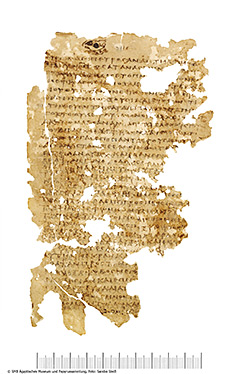P. 11765
Embezzlement, fraud, selfishness and divine punishment are the central themes of the displayed text fragment. Already over 2,000 years ago, people had to deal with these problems, which are still current today. Also, the here presented excerpt from Luke’s Acta Apostolorum is one of the oldest New Testament writings on parchment.
The parchment contains Greek text from an unknown origin and was probably written at the end of the 2nd or beginning of the 3rd century. It is inscribed with a column of text on both sides, for which it is unfortunately no longer possible to reconstruct the author. However, the careful handwriting suggests that a professional writer wrote it.
From the page numbers (15/16) that are still recognizable on the top of the two pages, it can be assumed that the codex, from which this sheet originated, only contained the Acts of the Apostles and not the Gospel of Luke. The number and length of lines on the two pages allow to draw conclusions about the former scope of the codex. Since the full text of the Acta Apostolorum is known and both sheets were inscribed with 32 lines each, the complete codex was probably circa 72 pages long.
The part of the Acta Apostolorum visible in the exhibition comprises sections 5.3–12. These lines tell a part of the story of the married couple Ananias and Sapphira. The story itself starts earlier but its beginning is not included on this parchment fragment.
In the story, Ananias and Sapphira sell a piece of land and want to donate the profits to the apostles. However, they decide to keep a part of the profits for themselves. The fragment begins after Ananias gave parts of the profits to the apostles. Peter immediately rises to speak and asks Ananias why he had embezzled part of the profits, accusing him of not cheating the people but God himself. Ananias is so horrified that he drops dead and is carried out and buried by the disciples. After about three hours, Sapphira appears without knowing what had happened to her husband. Peter also asks her if they had sold the property for the amount given by Ananias, which she affirms. Peter tells her that her husband had already died and was buried because of this fraud against God. Also, it was her fate to be buried alongside him. Sapphira then also dies and is buried next to Ananias. Afterwards, everyone in the community and those who heard the story were in great fear.
Nowadays, it may be difficult to understand why the offences of Ananias and Sapphira had such serious consequences. The passage suggests that the sale of the entire property and the donation of the full sum of the profits presented a kind of entry ritual into the early Christian community. In order to become part of the community, all private property claims needed to be abandoned and transferred to the community. Consequently, the offence of Ananias and Sapphira was to claim ownership of part of the profits from the sale and at the same time try to deceive Peter and the Holy Spirit. It remains unanswered whether the punishment was appropriate or not. The page in the exhibition ends with a summary of unspecified miracles and signs that were carried out by the apostles.



